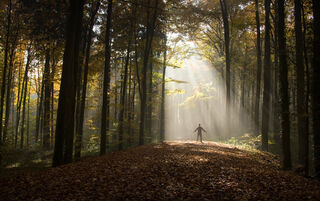Environment
Contact With Nature as Therapy
The power of ecotherapy.
Posted June 4, 2022 Reviewed by Vanessa Lancaster
Key points
- A massive amount of research shows that contact with nature is therapeutic, leading to the term ecotherapy.
- In Japan, forest bathing is an important aspect of preventative medicine.
- Contact with nature is therapeutic because it has a meditative effect and because we feel an instinctive sense of "at-home-ness" in nature.

At the moment, it’s ‘grading time’ at my university. The other day, I felt tired and dazed after reading about 15,000 words of students’ papers. My mind was so clouded that I felt that I couldn’t read another word. I needed a break, but rather than going for a lie-down, I decided to go for a walk in the woods.
I walked for about an hour, staring at the trees and leaves and watching the stream flow downhill. After a while, I left the woods and wandered through some fields overlooking the town. It was a windy day, and I felt invigorated, watching the long grass and flowers tilting to one side and the clouds above me flowing quickly by.
When I got back home, I felt rejuvenated. My mind felt clear and fresh, and I was ready to carry on wading through my students’ papers.
One way of explaining this experience is in terms of what the psychologists Stephen and Rachel Kaplan called attention restoration theory. This describes how contact with nature can replenish our mental resources, particularly after a long time in the stressful, energy-draining environment of the city.
Kaplan and Kaplan described four stages of restoration, beginning with a clearing of the mind, in which thoughts begin to slow down and fade away. The second stage is mental fatigue recovery when we de-focus our attention and allow our mental energies to recharge. Then we gently focus our attention on the natural environment, which further reduces the chatter of our minds, almost as if we are meditating. Finally, we enter a stage of ‘reflection and restoration’ in which we fully relax, feel a sense of mental freshness, and are able to reflect anew on our lives and our goals.
Other Beneficial Aspects of Connection With Nature
Attention restoration is just one of the beneficial effects of contact with nature. These effects have been extensively researched in recent years, leading to the coining of the phrase “ecotherapy.”
The first systematic research in this area took place in Japan, where in the 1980s, the government funded studies into the practice of ‘forest-bathing’ (shinrin-yoku). This simply means walking quietly through a forest, observing the natural phenomena around you while breathing slowly and deeply.
Many studies have found that the practice has significant mental and physical benefits, such as reduced blood pressure, lower cortisol levels, a stronger immune system, better sleep, and improved memory and concentration.1 As a result, shinrin-yoku became an important part of Japan’s healthcare system as a preventative medicine tool.
More recent research outside Japan has found that even forms of “light” contact with nature have positive effects. Simply watching a slide show of natural images or a nature-based TV programme has been shown to elevate mood and energy levels.2 Employees and schoolchildren who have views of nature – or whose working spaces include indoor plants – develop increased well-being, better concentration, and work performance.3
In 2020, researchers at University College London studied children who engaged in outdoor activities at a local wildlife trust. They found that the children showed increased well-being and health. In children who lived in an urban environment with little contact with nature, the positive effects were especially strong.4 There is also evidence that contact with nature can alleviate some of the symptoms of ADHD in children.5
Why is contact with nature so therapeutic?
The above therapeutic effects make sense when we consider that, until very recent times, all human beings lived in constant close contact with nature. A feeling of connection to nature is deeply ingrained in us. Nature has always been our home, and so we always feel most comfortable when we are close to it. (The biologist E.O. Wilson referred to this attraction to nature as ‘biophilia.’)
Conversely, a lack of contact with nature may induce a feeling of unease. We may suffer from what the author Richard Louv has called "nature deficit disorder." In my view, the effects of nature deficit disorder have not been fully appreciated by psychologists and medical professionals. I believe that a lack of contact with nature can be a significant factor in depression and other mental health conditions (including ADHD).
As the practice of forest-bathing implies, contact with nature is akin to a meditative practice. It, therefore, brings many of the benefits associated with meditation. It focuses our attention outside our minds so that we no longer ruminate on the problems and pressures of our lives. It slows both our minds and bodies down, opening up an inner space where we can relax and reconnect to ourselves.
It re-energises our perceptions so that the world around us becomes more real and beautiful. We no longer feel trapped inside our minds and bodies but feel connected to our surroundings. Therefore, all of the mental and physical benefits of mindfulness meditation also apply to contact with nature.
The Increasing Popularity of Ecotherapy
In recent years, other countries have begun to follow Japan’s example, incorporating ecotherapy into their health care systems. In countries such as New Zealand and the UK – where I live – it isn’t uncommon for healthcare professionals to offer patients green prescriptions. In the UK, some medical practices prescribe conservation activities, gardening programmes, walking, or cycling in nature.
In 2020, the UK government announced a £4 million (approx. $6 million dollars) green prescribing pilot at four rural locations. The pilot aims to find the best way to embed green prescribing into communities and improve mental health outcomes. In New Zealand, research has already established that green prescribing is one of the most cost-effective ways of promoting health.
For healthcare providers, one of the attractions of ecotherapy is that it is free, as opposed to expensive sessions of talking therapy or courses of medication such as anti-depressants (although pharmaceutical companies may not feel quite the same way). And for us individuals, ecotherapy is a reminder that there is a powerful source of well-being that is always close at hand and easy to access – well-being that itself seems entirely natural, like the relief and relaxation we feel after returning home.
To find a therapist near you, visit the Psychology Today Therapy Directory.
References
(1) Tsunetsugu, Y., Park, B.J. & Miyazaki,Y. (2010) Trends in research related to “Shinrin-yoku” (taking in the forest atmosphere or forest bathing) in Japan. Environmental Health and Preventive Medicine, 15, pp27-37.
(2) Howell,A.J., Dopko, R.L., Passmore, H.A. & Buro,K. (2011) Nature connectedness: Associations with well-being and mindfulness. Personality and Individual Differences, 51, pp166-171; Saraglou,V., Buxant,C. & Tilquin,J. (2008) Positive emotions as leading to religion and spirituality. Journal of Positive Psychology, 3,pp165-173.
(3) Raanaas, R.K., Evensen, K.H., Rich, D., Sjøstrøm, G. & Patil, G., (2011). Benefits of indoor plants on attention capacity in an office setting. Journal of Environmental Psychology, 31(1), pp.99-105; Bringslimark, T., Hartig, T. & Patil, G., (2011). Adaptation to windowlessness: do office workers compensate for a lack of visual access to the outdoors? Environment and behavior, 43(4), pp.469-487.
(4) Sheldrake, R. and Reiss, M., (2020). The impact of nature on children’s wellbeing. Environmental Education, 124, pp.16-17.
(5) Faber Taylor, A. & Kuo, F.E., (2009). Children with attention deficits concentrate better after walk in the park. Journal of attention disorders, 12(5), pp.402-409; Van den Berg, A.E. & Van den Berg, C.G., (2011). A comparison of children with ADHD in a natural and built setting. Child: care, health and development, 37(3), pp.430-439.




